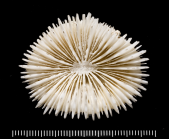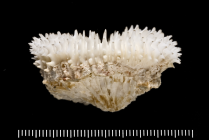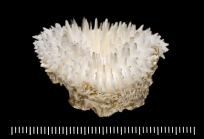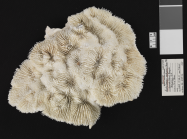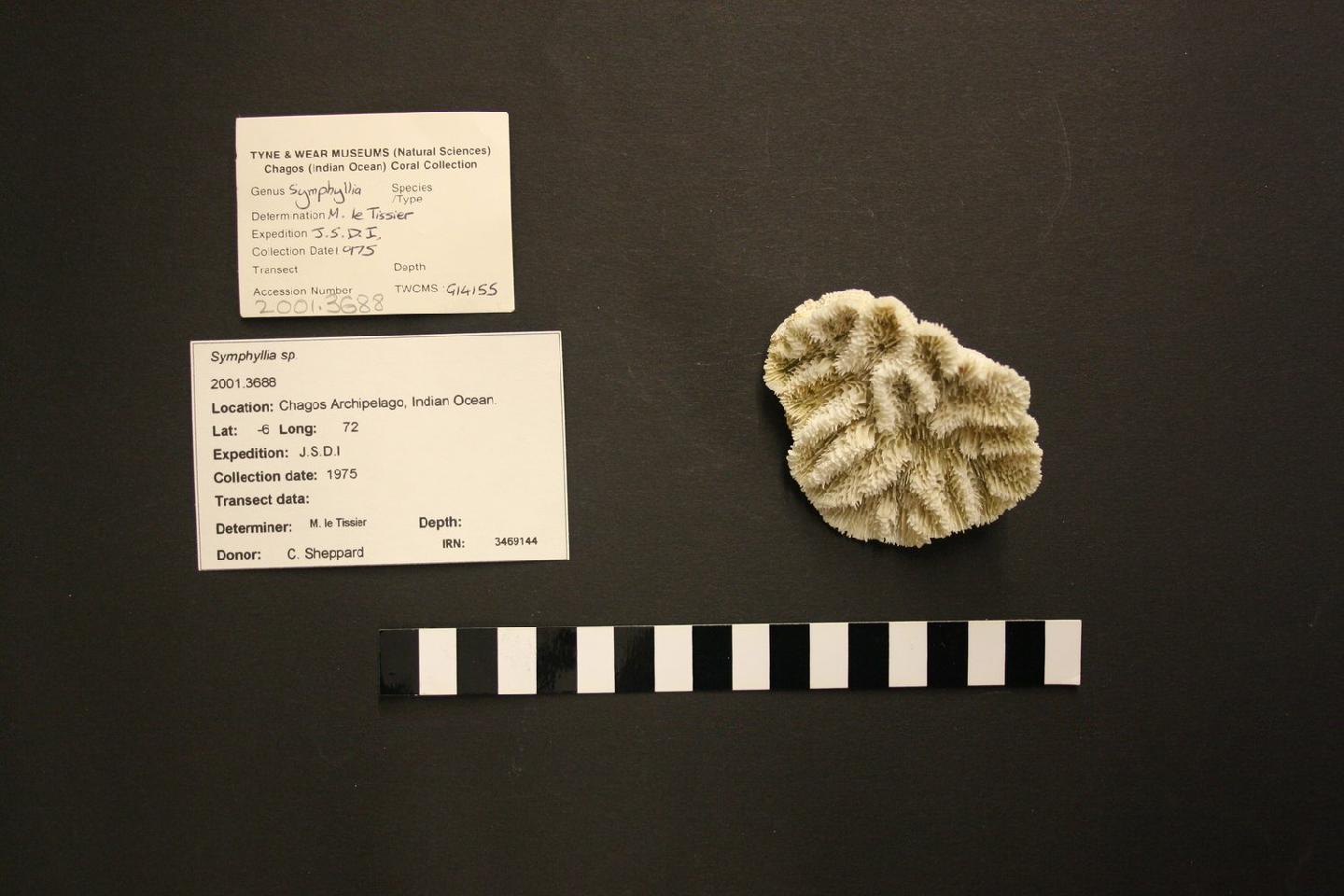WoRMS taxon details
Lobophyllia de Blainville, 1830
205310 (urn:lsid:marinespecies.org:taxname:205310)
accepted
Genus
Madrepora corymbosa Forskål, 1775 accepted as Lobophyllia corymbosa (Forskål, 1775) (type by subsequent designation)
Australomussa Veron, 1985 · unaccepted > junior subjective synonym
Lobophyllia (Palauphyllia) Yabe, Sugiyama & Eguchi, 1936 · unaccepted > junior subjective synonym
Mussa (Symphyllia) Milne Edwards & Haime, 1848 · unaccepted > junior subjective synonym
Palauphyllia Yabe, Sugiyama & Eguchi, 1936 · unaccepted > junior subjective synonym
Parascolymia Wells, 1964 · unaccepted > junior subjective synonym
Symphillia Milne Edwards & Haime, 1848 · unaccepted > junior subjective synonym (misspelling)
Symphyllia Milne Edwards & Haime, 1848 · unaccepted > junior subjective synonym
- Species Lobophyllia agaricia (Milne Edwards & Haime, 1849)
- Species Lobophyllia corymbosa (Forskål, 1775)
- Species Lobophyllia costata (Dana, 1846)
- Species Lobophyllia dentata Veron, 2000
- Species Lobophyllia diminuta Veron, 1985
- Species Lobophyllia erythraea (Klunzinger, 1879)
- Species Lobophyllia flabelliformis Veron, 2000
- Species Lobophyllia grandis Latypov, 2006 (accepted > unreplaced junior homonym)
- Species Lobophyllia grandis Milne Edwards & Haime, 1849
- Species Lobophyllia hassi (Pillai & Scheer, 1976)
- Species Lobophyllia hataii Yabe, Sugiyama & Eguchi, 1936
- Species Lobophyllia hemprichii (Ehrenberg, 1834)
- Species Lobophyllia ishigakiensis (Veron, 1990)
- Species Lobophyllia radians (Milne Edwards & Haime, 1849)
- Species Lobophyllia recta (Dana, 1846)
- Species Lobophyllia robusta Yabe & Sugiyama, 1936
- Species Lobophyllia rowleyensis (Veron, 1985)
- Species Lobophyllia serrata Veron, 2000
- Species Lobophyllia sinuosa (Quoy & Gaimard, 1833)
- Species Lobophyllia valenciennesii (Milne Edwards & Haime, 1849)
- Species Lobophyllia vitiensis (Brüggemann, 1877)
- Subgenus Lobophyllia (Palauphyllia) Yabe, Sugiyama & Eguchi, 1936 accepted as Lobophyllia de Blainville, 1830 (unaccepted > junior subjective synonym)
- Species Lobophyllia (Palauphyllia) hataii Yabe, Sugiyama & Eguchi, 1936 accepted as Lobophyllia hataii Yabe, Sugiyama & Eguchi, 1936 (unaccepted > superseded combination)
- Species Lobophyllia angulosa (Pallas, 1766) accepted as Mussa angulosa (Pallas, 1766) (unaccepted > superseded combination)
- Species Lobophyllia aspera Milne Edwards & Haime, 1849 accepted as Lobophyllia hemprichii (Ehrenberg, 1834) (unaccepted > junior subjective synonym)
- Species Lobophyllia aurea Quoy & Gaimard, 1833 accepted as Tubastraea aurea (Quoy & Gaimard, 1833) (unaccepted > superseded combination, basionym)
- Species Lobophyllia carduus (Ellis & Solander, 1786) accepted as Mussa angulosa (Pallas, 1766) (unaccepted > junior subjective synonym)
- Species Lobophyllia cristata (Esper, 1789) accepted as Lobophyllia hemprichii (Ehrenberg, 1834) (unaccepted > junior subjective synonym)
- Species Lobophyllia cytherea (Dana, 1846) accepted as Lobophyllia hemprichii (Ehrenberg, 1834) (unaccepted > superseded combination)
- Species Lobophyllia dentatus Veron, 2000 accepted as Lobophyllia dentata Veron, 2000 (unaccepted > incorrect grammatical agreement of specific epithet)
- Species Lobophyllia echinata Milne Edwards & Haime, 1849 accepted as Lobophyllia hemprichii (Ehrenberg, 1834) (unaccepted > junior subjective synonym)
- Species Lobophyllia eydouxi Milne Edwards & Haime, 1849 accepted as Lobophyllia corymbosa (Forskål, 1775) (unaccepted > junior subjective synonym, misspelling)
- Species Lobophyllia eydouxii Milne Edwards & Haime, 1849 accepted as Lobophyllia corymbosa (Forskål, 1775) (unaccepted > junior subjective synonym)
- Species Lobophyllia fastigiata (Pallas, 1766) accepted as Eusmilia fastigiata (Pallas, 1766) (unaccepted > superseded combination)
- Species Lobophyllia fistulosa Milne Edwards & Haime, 1849 accepted as Lobophyllia corymbosa (Forskål, 1775) (unaccepted > junior subjective synonym)
- Species Lobophyllia flexuosa Milne Edwards & Haime, 1849 accepted as Lobophyllia hemprichii (Ehrenberg, 1834) (unaccepted > junior subjective synonym)
- Species Lobophyllia glabrescens (Chamisso & Eysenhardt, 1821) accepted as Euphyllia glabrescens (Chamisso & Eysenhardt, 1821) (unaccepted > superseded combination)
- Species Lobophyllia lacinians Milne Edwards & Haime, 1849 accepted as Mussa lacinians (Milne Edwards & Haime, 1849) (unaccepted > superseded combination, basionym)
- Species Lobophyllia multilobata (Dana, 1846) accepted as Lobophyllia hemprichii (Ehrenberg, 1834) (unaccepted > junior subjective synonym)
- Species Lobophyllia pachysepta Chevalier, 1975 accepted as Acanthastrea pachysepta (Chevalier, 1975) (unaccepted > superseded combination, basionym)
- Species Lobophyllia ringens Milne Edwards & Haime, 1849 accepted as Lobophyllia corymbosa (Forskål, 1775) (unaccepted > junior subjective synonym)
- Species Lobophyllia rudis Milne Edwards & Haime, 1849 accepted as Lobophyllia corymbosa (Forskål, 1775) (unaccepted > junior subjective synonym)
- Species Lobophyllia serratus Veron, 2000 accepted as Lobophyllia serrata Veron, 2000 (unaccepted > incorrect grammatical agreement of specific epithet)
- Species Lobophyllia sinensis Milne Edwards & Haime, 1849 accepted as Lobophyllia hemprichii (Ehrenberg, 1834) (unaccepted > junior subjective synonym)
- Species Lobophyllia tenuidentata Milne Edwards & Haime, 1849 accepted as Lobophyllia hemprichii (Ehrenberg, 1834) (unaccepted > junior subjective synonym)
- Species Lobophyllia wellsi Ma, 1959 accepted as Oulophyllia wellsi (Ma, 1959) (unaccepted > superseded combination, basionym)
- Species Lobophyllia daniana Milne Edwards & Haime, 1849 (uncertain > taxon inquirendum)
- Species Lobophyllia dipsacea (Dana, 1846) (uncertain > taxon inquirendum)
- Species Lobophyllia labyrinthica (Bassett-Smith, 1890) (uncertain > taxon inquirendum)
- Species Lobophyllia simplex (Crossland, 1948) (uncertain > taxon inquirendum)
- Species Lobophyllia subtilis (Rehberg, 1892) (uncertain > taxon inquirendum)
marine, fresh, terrestrial
de Blainville, H. M. (1830). Zoophytes. In: Dictionnaire des sciences naturelles, dans lequel on traitre méthodiquement des differéns êtres de la nature, considérés soit en eux-mêmes, d'après l'état actuel de nos connoissances, soit relativement à l'utlité qu'en peuvent retirer la médicine, l'agriculture, le commerce et les arts. Edited by F. G. Levrault. Tome 60. Paris, Le Normat. Pp. 548, pls. 68. <em>Paris, 1830.</em> 60 : 1-546., available online at https://www.biodiversitylibrary.org/page/25318344 [details]
Description 'Animaux actiniformes, pourvus d'une grande quantité de tentacules cylindriques, plus ou moins longs, sortant de loges...
Status Lobophyllia was first described by de Blainville (1830: 321) for seven species: (1) L. glabrescens (De Chamisso and...
Description Colonies are phaceloid to flabello-meandroid, either flat-topped or dome-shaped. Corallites and/or valleys are large. Septa...
Description 'Animaux actiniformes, pourvus d'une grande quantité de tentacules cylindriques, plus ou moins longs, sortant de loges coniques, à ouverture subcirculaire, quelquefois même alongées et sinueuses, partagées en un grand nombre de sillons par des lamelles tranchantes, laciniées, situées à l'extrémité des branches, en général peu nombreuses et fasciculées, composant un polypier calcaire, fixe, turbiné, strié longitudinalement à l'extérieur et très-lacuneux à l'intérieur.' (de Blainville, 1830: 321) [details]
Status Lobophyllia was first described by de Blainville (1830: 321) for seven species: (1) L. glabrescens (De Chamisso and...
Status Lobophyllia was first described by de Blainville (1830: 321) for seven species: (1) L. glabrescens (De Chamisso and Eysenhardt, 1821: 369); (2) L. angulosa (Pallas, 1766: 299); (3) L. aurantiaca (= L. aurea Quoy and Gaimard, 1833: 195); (4) L. fastigiata (Pallas, 1766: 301); (5) L. corymbosa (Forskål, 1775: 137); (6) L. sinuosa (Lamarck, 1816: 229); and (7) L. carduus (Ellis and Solander, 1786: 153). The first, second and fourth are the type species of Euphyllia Dana, 1846: 40, Mussa Oken, 1815: 73, and Eusmilia Milne Edwards and Haime, 1848b, vol. 27: 467, respectively (Matthai, 1928), while the third belongs to Tubastraea Lesson, 1829: 93 (Cairns, 2001). The fifth species was thus chosen to be the type species of Lobophyllia, and the genus resurrected by Matthai (1928: 208) to incorporate all the Indo-Pacific species of Mussa as defined by Milne Edwards and Haime (1857), i.e. L. corymbosa (Forskål, 1775: 137), L. costata (Dana, 1846: 179; but see Sheppard, 1987) and L. hemprichii (Ehrenberg, 1834: 325). A further eight species were described in this genus by Yabe et al. (1936; two species), Chevalier (1975; one species), Veron (1985, 2000; four species) and Latypov (2006; one species). However, our analyses demonstrate that L. pachysepta Chevalier, 1975: 269, is more closely related to Acanthastrea than to other Lobophyllia species, including the type L. corymbosa, and thus should be regarded as an Acanthastrea species (Fig. 2). Both molecular and morphological trees also show that Acanthastrea ishigakiensis Veron, 1990: 132, Parascolymia and nearly all Symphyllia species are nested amongst Lobophyllia species in subclade I (sensu Arrigoni et al., 2014c), supporting the call by Arrigoni et al. (2014c) to consolidate these taxa into a single genus. Therefore, A. ishigakiensis, both Parascolymia species and six Symphyllia species are herein transferred into Lobophyllia, which now comprises a clade of 19 closely-related species. Many of these species form single lineages, but some are paraphyletic, including L. corymbosa, L. hemprichii, L. rowleyensis and L. vitiensis (see Arrigoni et al., 2014b: fig. 9, 2014c: fig. 1). The holotype of L. corymbosa, type species of Lobophyllia, is at the ZMUC (ANT-000526), where the types of other species described by Forskål (1775) could be found today, e.g. lectotype of Dipsastraea favus (Forskål, 1775: 132; ZMUC ANT-000466) and syntypes of Cyphastrea serailia (Forskål, 1775: 135; ZMUC ANT-000367 to ANT-000373). Lobophyllia is widely distributed on the reefs of Indo-Pacific, present from the Red Sea and East Africa to as far east as the Marshall Islands in the Northern Hemisphere (Veron, 2000) and Pitcairn Islands in the Southern Hemisphere (Glynn et al., 2007). [details]
Description Colonies are phaceloid to flabello-meandroid, either flat-topped or dome-shaped. Corallites and/or valleys are large. Septa...
Description Colonies are phaceloid to flabello-meandroid, either flat-topped or dome-shaped. Corallites and/or valleys are large. Septa are large with very long teeth. Columella centres are broad and compact. Polyps are extended only at night. Tentacles usually have white tips. (Veron, 1986 <57>) [details]
Hoeksema, B. W.; Cairns, S. (2025). World List of Scleractinia. Lobophyllia de Blainville, 1830. Accessed through: World Register of Marine Species at: https://www.marinespecies.org/aphia.php?p=taxdetails&id=205310 on 2025-07-14
Date
action
by
2006-09-22 06:50:38Z
changed
Martinez, Olga
![]() The webpage text is licensed under a Creative Commons
Attribution 4.0 License
The webpage text is licensed under a Creative Commons
Attribution 4.0 License
Nomenclature
original description
de Blainville, H. M. (1830). Zoophytes. In: Dictionnaire des sciences naturelles, dans lequel on traitre méthodiquement des differéns êtres de la nature, considérés soit en eux-mêmes, d'après l'état actuel de nos connoissances, soit relativement à l'utlité qu'en peuvent retirer la médicine, l'agriculture, le commerce et les arts. Edited by F. G. Levrault. Tome 60. Paris, Le Normat. Pp. 548, pls. 68. <em>Paris, 1830.</em> 60 : 1-546., available online at https://www.biodiversitylibrary.org/page/25318344 [details]
original description (of Symphyllia Milne Edwards & Haime, 1848) Milne Edwards, H.; Haime, J. (1848). Note sur la classification de la deuxième tribu de la famille des Astréides. <em>Comptes rendus hebdomadaires des séances de l'Académie des sciences, Paris.</em> 27: 490–497., available online at https://doi.org/10.5962/bhl.part.29692 [details]
original description (of Australomussa Veron, 1985) Veron JEN. (1985). New Scleractinia from Australian coral reefs. <em>Records of the Western Australian Museum.</em> 12: 147-183. [details]
original description (of Parascolymia Wells, 1964) Wells JW. (1964). The recent solitary mussid scleractinian corals. <em>Zoologische Mededelingen, Leiden.</em> 39: 375-384. [details]
original description (of Mussa (Symphyllia) Milne Edwards & Haime, 1848) Milne Edwards, H.; Haime, J. (1848). Note sur la classification de la deuxième tribu de la famille des Astréides. <em>Comptes rendus hebdomadaires des séances de l'Académie des sciences, Paris.</em> 27: 490–497., available online at https://doi.org/10.5962/bhl.part.29692 [details]
original description (of Lobophyllia (Palauphyllia) Yabe, Sugiyama & Eguchi, 1936) Yabe H, Sugiyama T, Eguchi M. (1936). Recent reef-building corals from Japan and the South Sea Islands under the Japanese mandate. I. <em>The Science reports of the Tôhoku Imperial University, Sendai, 2nd Series (Geologie).</em> Special Volume 1: 1-66, pls. 1-59. [details]
basis of record Veron JEN. (1986). Corals of Australia and the Indo-Pacific. <em>Angus & Robertson Publishers.</em> [details]
original description (of Symphyllia Milne Edwards & Haime, 1848) Milne Edwards, H.; Haime, J. (1848). Note sur la classification de la deuxième tribu de la famille des Astréides. <em>Comptes rendus hebdomadaires des séances de l'Académie des sciences, Paris.</em> 27: 490–497., available online at https://doi.org/10.5962/bhl.part.29692 [details]
original description (of Australomussa Veron, 1985) Veron JEN. (1985). New Scleractinia from Australian coral reefs. <em>Records of the Western Australian Museum.</em> 12: 147-183. [details]
original description (of Parascolymia Wells, 1964) Wells JW. (1964). The recent solitary mussid scleractinian corals. <em>Zoologische Mededelingen, Leiden.</em> 39: 375-384. [details]
original description (of Mussa (Symphyllia) Milne Edwards & Haime, 1848) Milne Edwards, H.; Haime, J. (1848). Note sur la classification de la deuxième tribu de la famille des Astréides. <em>Comptes rendus hebdomadaires des séances de l'Académie des sciences, Paris.</em> 27: 490–497., available online at https://doi.org/10.5962/bhl.part.29692 [details]
original description (of Lobophyllia (Palauphyllia) Yabe, Sugiyama & Eguchi, 1936) Yabe H, Sugiyama T, Eguchi M. (1936). Recent reef-building corals from Japan and the South Sea Islands under the Japanese mandate. I. <em>The Science reports of the Tôhoku Imperial University, Sendai, 2nd Series (Geologie).</em> Special Volume 1: 1-66, pls. 1-59. [details]
basis of record Veron JEN. (1986). Corals of Australia and the Indo-Pacific. <em>Angus & Robertson Publishers.</em> [details]
Other
additional source
Neave, Sheffield Airey. (1939-1996). Nomenclator Zoologicus vol. 1-10 Online. <em>[Online Nomenclator Zoologicus at Checklistbank. Ubio link has gone].</em> , available online at https://www.checklistbank.org/dataset/126539/about [details]
additional source Daly, M.M., Fautin D.G., Cappola V.A., 2003. Systematics of the Hexacorallia (Cnidaria: Anthozoa). Zoological Journal of the Linnean Society 139 3: 419-437.
page(s): 424-425, 427-428 [details] Available for editors [request]
[request]
additional source Veron JEN, Pichon M. (1980). Scleractinia of Eastern Australia – Part III. Family Agariciidae, Siderastreidae, Fungiidae, Oculinidae, Merulinidae, Mussidae, Pectinidae, Caryophyllidae, Dendrophylliidae. <em>Australian Institute of Marine Science Monograph Series.</em> 4: 1-459. [details]
additional source Veron JEN. (2000). Corals of the World. Vol. 1–3. <em>Australian Institute of Marine Science and CRR, Queensland, Australia.</em> [details]
additional source Wells JW. (1936). The nomenclature and type species of some genera of recent and fossil corals. <em>American Journal of Science.</em> 31: 97-134., available online at https://ajsonline.org/article/61464 [details]
additional source Budd AF, Fukami H, Smith ND, Knowlton N. (2012). Taxonomic classification of the reef coral family Mussidae (Cnidaria: Anthozoa: Scleractinia). <em>Zoological Journal of the Linnean Society.</em> 166 (3): 465-529., available online at https://doi.org/10.1111/j.1096-3642.2012.00855.x [details]
additional source Matthai G. (1928). A Monograph of the Recent meandroid Astraeidae. <em>Catalogue of the Madreporarian Corals in the British Museum (Natural History).</em> 7: 1-288, pls. 1-72. [details] Available for editors [request]
[request]
additional source Yabe H, Sugiyama T. (1935). Revised list of the reef-corals from the Japanese seas and of the fossil reef corals of the raised reefs and the Ryukyu limestone of Japan. <em>Journal of the Geological Society of Japan.</em> 42: 379-403.
page(s): 395 [details]
additional source Cairns, S.D., L. Gershwin, F.J. Brook, P. Pugh, E.W. Dawson, O.V. Ocaña, W. Vervoort, G. Williams, J.E. Watson, D.M. Opresko, P. Schuchert, P.M. Hine, D.P. Gordon, H.I. Campbell, A.J. Wright, J.A.Sánchez & D.G. Fautin. (2009). Phylum Cnidaria: corals, medusae, hydroids, myxozoans. <em>in: Gordon, D.P. (Ed.) (2009). New Zealand inventory of biodiversity: 1. Kingdom Animalia: Radiata, Lophotrochozoa, Deuterostomia.</em> :59-101., available online at https://repository.si.edu/handle/10088/8431 [details] Available for editors [request]
[request]
additional source Arrigoni R, Terraneo TI, Galli P, Benzoni F (2014) Lobophylliidae (Cnidaria, Scleractinia) reshuffled: Pervasive . non-monophyly at genus level. Molecular Phylogenetics and Evolution 73: 60-64. [details]
additional source Veron JEN, Pichon M. (1982). Scleractinia of Eastern Australia – Part IV. Family Poritidae. <em>Australian Institute of Marine Science Monograph Series.</em> 5: 1-159.
page(s): 139 [details]
additional source Huang D, Arrigoni R, Benzoni F, Fukami H, Knowlton N, Smith ND, Stolarski J, Chou LM, Budd AF. (2016). Taxonomic classification of the reef coral family Lobophylliidae (Cnidaria: Anthozoa: Scleractinia). <em>Zoological Journal of the Linnean Society.</em> 178(3): 436-481., available online at https://doi.org/10.1111/zoj.12391 [details]
additional source Boshoff, P.H. (1981). An annotated checklist of Southern Africa Scleractinia. <em>Oceanographic Research Institute Investigational Report, Durban.</em> 49: 1-45.
page(s): 26 [details]
additional source Tkachenko, K. S.; Wu, B. J.; Fang, L. S.; Fan, T. Y. (2007). Dynamics of a coral reef community after mass mortality of branching Acropora corals and an outbreak of anemones. Marine Biology, 151, 185-194
page(s): 187 [details]
additional source Daly, M.M., Fautin D.G., Cappola V.A., 2003. Systematics of the Hexacorallia (Cnidaria: Anthozoa). Zoological Journal of the Linnean Society 139 3: 419-437.
page(s): 424-425, 427-428 [details] Available for editors
additional source Veron JEN, Pichon M. (1980). Scleractinia of Eastern Australia – Part III. Family Agariciidae, Siderastreidae, Fungiidae, Oculinidae, Merulinidae, Mussidae, Pectinidae, Caryophyllidae, Dendrophylliidae. <em>Australian Institute of Marine Science Monograph Series.</em> 4: 1-459. [details]
additional source Veron JEN. (2000). Corals of the World. Vol. 1–3. <em>Australian Institute of Marine Science and CRR, Queensland, Australia.</em> [details]
additional source Wells JW. (1936). The nomenclature and type species of some genera of recent and fossil corals. <em>American Journal of Science.</em> 31: 97-134., available online at https://ajsonline.org/article/61464 [details]
additional source Budd AF, Fukami H, Smith ND, Knowlton N. (2012). Taxonomic classification of the reef coral family Mussidae (Cnidaria: Anthozoa: Scleractinia). <em>Zoological Journal of the Linnean Society.</em> 166 (3): 465-529., available online at https://doi.org/10.1111/j.1096-3642.2012.00855.x [details]
additional source Matthai G. (1928). A Monograph of the Recent meandroid Astraeidae. <em>Catalogue of the Madreporarian Corals in the British Museum (Natural History).</em> 7: 1-288, pls. 1-72. [details] Available for editors
additional source Yabe H, Sugiyama T. (1935). Revised list of the reef-corals from the Japanese seas and of the fossil reef corals of the raised reefs and the Ryukyu limestone of Japan. <em>Journal of the Geological Society of Japan.</em> 42: 379-403.
page(s): 395 [details]
additional source Cairns, S.D., L. Gershwin, F.J. Brook, P. Pugh, E.W. Dawson, O.V. Ocaña, W. Vervoort, G. Williams, J.E. Watson, D.M. Opresko, P. Schuchert, P.M. Hine, D.P. Gordon, H.I. Campbell, A.J. Wright, J.A.Sánchez & D.G. Fautin. (2009). Phylum Cnidaria: corals, medusae, hydroids, myxozoans. <em>in: Gordon, D.P. (Ed.) (2009). New Zealand inventory of biodiversity: 1. Kingdom Animalia: Radiata, Lophotrochozoa, Deuterostomia.</em> :59-101., available online at https://repository.si.edu/handle/10088/8431 [details] Available for editors
additional source Arrigoni R, Terraneo TI, Galli P, Benzoni F (2014) Lobophylliidae (Cnidaria, Scleractinia) reshuffled: Pervasive . non-monophyly at genus level. Molecular Phylogenetics and Evolution 73: 60-64. [details]
additional source Veron JEN, Pichon M. (1982). Scleractinia of Eastern Australia – Part IV. Family Poritidae. <em>Australian Institute of Marine Science Monograph Series.</em> 5: 1-159.
page(s): 139 [details]
additional source Huang D, Arrigoni R, Benzoni F, Fukami H, Knowlton N, Smith ND, Stolarski J, Chou LM, Budd AF. (2016). Taxonomic classification of the reef coral family Lobophylliidae (Cnidaria: Anthozoa: Scleractinia). <em>Zoological Journal of the Linnean Society.</em> 178(3): 436-481., available online at https://doi.org/10.1111/zoj.12391 [details]
additional source Boshoff, P.H. (1981). An annotated checklist of Southern Africa Scleractinia. <em>Oceanographic Research Institute Investigational Report, Durban.</em> 49: 1-45.
page(s): 26 [details]
additional source Tkachenko, K. S.; Wu, B. J.; Fang, L. S.; Fan, T. Y. (2007). Dynamics of a coral reef community after mass mortality of branching Acropora corals and an outbreak of anemones. Marine Biology, 151, 185-194
page(s): 187 [details]
 Present
Present  Inaccurate
Inaccurate  Introduced: alien
Introduced: alien  Containing type locality
Containing type locality
From editor or global species database
Comparison This genus is delimited by two synapomorphies, uniserial corallites (likelihood of 1.00 based on the Mk1 model) and vesicular endotheca (likelihood 1.00). However, a reduction in the number of centres occurs among L. corymbosa, L. dentata, L. diminuta and L. serrata. On the one hand, Lobophyllia vitiensis and L. rowleyensis, previously in Parascolymia, form a clade that is supported by moderate bootstrap value (71) and decay index (2), with the synapomorphies extracalicular budding (likelihood 1.00) and polymorphic corallites (likelihood 1.00). On the other hand, species that had in the past been separated into the genera Lobophyllia and Symphyllia (sensu Matthai, 1928; Veron, 2000) do not form clades on both morphological and molecular trees. Symphyllia has often been compared to Lobophyllia, as both possess lamellar linkages between columellar centres (Matthai, 1928; Vaughan and Wells, 1943; Wells, 1956), but the former can be differentiated by its longer, meandering valleys bordered by fused walls (Chevalier, 1975; Wood, 1983; Veron, 1986, 2000). However, this distinction is problematic because Symphyllia valenciennesi Milne Edwards and Haime, 1849a, vol. 11: 256 (see Chevalier, 1975), and L. hataii Yabe, Sugiyama and Eguchi, 1936: 44, have shallow and straight valleys that radiate from the colony center, with the periphery being flabello-meandroid (Veron, 2000). These two species do not group together on the morphological phylogeny, but rather form a paraphyletic group with the rest of the Lobophyllia sensu stricto, indicating that these characters are not reliable in delimiting species groups within subclade I (sensu Arrigoni et al., 2014c). Cynarina is the sister genus of Lobophyllia, but is morphologically distinct from the latter as it is solitary and may be free-living, have weak or moderate development of septal lobes, low-moderate (tabular) endotheca, and strong costa medial lines. Although Lobophyllia is restricted to the Indo-Pacific, it has historically been confused with the Atlantic genus Mussa because they share many macromorphological characters (Chevalier, 1975; Veron, 2000). However, the presence of lamellar linkages between columellar centres in Lobophyllia, as mentioned above, is a key distinguishing feature (Matthai, 1928). Furthermore, Mussa possesses several subcorallite traits that are not found in Lobophyllia: circular tooth base, pointed tooth tip, granules aligned on septal face, interarea formed by horizontal bands, parathecal walls with trabeculothecal elements, reduced thickening deposits and transverse septal crosses (Budd and Stolarski, 2009; Budd et al., 2012). [details]Description 'Animaux actiniformes, pourvus d'une grande quantité de tentacules cylindriques, plus ou moins longs, sortant de loges coniques, à ouverture subcirculaire, quelquefois même alongées et sinueuses, partagées en un grand nombre de sillons par des lamelles tranchantes, laciniées, situées à l'extrémité des branches, en général peu nombreuses et fasciculées, composant un polypier calcaire, fixe, turbiné, strié longitudinalement à l'extérieur et très-lacuneux à l'intérieur.' (de Blainville, 1830: 321) [details]
Diagnosis Colonial; submassive or massive. Budding intracalicular, and may also be extracalicular. Corallites monomorphic or polymorphic; discrete or uniserial. Monticules absent. Walls may be fused, or colonies may be phaceloid or flabello-meandroid. Calice width large (> 15 mm), with high relief (> 6 mm). Costosepta may or may not be confluent. Septa in ≥ four cycles (≥ 48 septa). Free septa irregular. Septa spaced < six septa per 5 mm. Costosepta unequal in relative thickness. Columellae trabecular and spongy (> three threads), < 1/4 of calice width, and discontinuous among adjacent corallites with lamellar linkage. Internal lobes absent. Epitheca reduced if present. Endotheca abundant (vesicular). Tooth base at midcalice elliptical-parallel. Tooth tip orientation parallel. Teeth tall (> 0.6 mm); widely spaced (> 1 mm), with > six teeth per septum. Tooth shape unequal between first and third order septa. Tooth size unequal between wall and septum. Granules scattered on septal face; weak (rounded). Interarea palisade. Walls formed by dominant paratheca and partial septotheca. Thickening deposits in concentric rings with extensive stereome. Costa centre clusters strong; > 0.6 mm between clusters; medial lines weak. Septum centre clusters weak; > 0.5 mm between clusters; medial lines weak. [details]
Remark Lobophyllia was first described by de Blainville (1830: 321) for seven species: (1) L. glabrescens (De Chamisso and Eysenhardt, 1821: 369); (2) L. angulosa (Pallas, 1766: 299); (3) L. aurantiaca (= L. aurea Quoy and Gaimard, 1833: 195); (4) L. fastigiata (Pallas, 1766: 301); (5) L. corymbosa (Forskål, 1775: 137); (6) L. sinuosa (Lamarck, 1816: 229); and (7) L. carduus (Ellis and Solander, 1786: 153). The first, second and fourth are the type species of Euphyllia Dana, 1846: 40, Mussa Oken, 1815: 73, and Eusmilia Milne Edwards and Haime, 1848b, vol. 27: 467, respectively (Matthai, 1928), while the third belongs to Tubastraea Lesson, 1829: 93 (Cairns, 2001). The fifth species was thus chosen to be the type species of Lobophyllia, and the genus resurrected by Matthai (1928: 208) to incorporate all the Indo-Pacific species of Mussa as defined by Milne Edwards and Haime (1857), i.e. L. corymbosa (Forskål, 1775: 137), L. costata (Dana, 1846: 179; but see Sheppard, 1987) and L. hemprichii (Ehrenberg, 1834: 325). A further eight species were described in this genus by Yabe et al. (1936; two species), Chevalier (1975; one species), Veron (1985, 2000; four species) and Latypov (2006; one species). However, our analyses demonstrate that L. pachysepta Chevalier, 1975: 269, is more closely related to Acanthastrea than to other Lobophyllia species, including the type L. corymbosa, and thus should be regarded as an Acanthastrea species. Both molecular and morphological trees also show that Acanthastrea ishigakiensis Veron, 1990: 132, Parascolymia and nearly all Symphyllia species are nested amongst Lobophyllia species in subclade I (sensu Arrigoni et al., 2014c), supporting the call by Arrigoni et al. (2014c) to consolidate these taxa into a single genus. Therefore, A. ishigakiensis, both Parascolymia species and six Symphyllia species are herein transferred into Lobophyllia, which now comprises a clade of 19 closely-related species. Many of these species form single lineages, but some are paraphyletic, including L. corymbosa, L. hemprichii, L. rowleyensis and L. vitiensis (see Arrigoni et al., 2014b: fig. 9, 2014c: fig. 1). The holotype of L. corymbosa, type species of Lobophyllia, is at the ZMUC (ANT-000526), where the types of other species described by Forskål (1775) could be found today, e.g. lectotype of Dipsastraea favus (Forskål, 1775: 132; ZMUC ANT-000466) and syntypes of Cyphastrea serailia (Forskål, 1775: 135; ZMUC ANT-000367 to ANT-000373). Lobophyllia is widely distributed on the reefs of Indo-Pacific, present from the Red Sea and East Africa to as far east as the Marshall Islands in the Northern Hemisphere (Veron, 2000) and Pitcairn Islands in the Southern Hemisphere (Glynn et al., 2007). [details]
Status Lobophyllia was first described by de Blainville (1830: 321) for seven species: (1) L. glabrescens (De Chamisso and Eysenhardt, 1821: 369); (2) L. angulosa (Pallas, 1766: 299); (3) L. aurantiaca (= L. aurea Quoy and Gaimard, 1833: 195); (4) L. fastigiata (Pallas, 1766: 301); (5) L. corymbosa (Forskål, 1775: 137); (6) L. sinuosa (Lamarck, 1816: 229); and (7) L. carduus (Ellis and Solander, 1786: 153). The first, second and fourth are the type species of Euphyllia Dana, 1846: 40, Mussa Oken, 1815: 73, and Eusmilia Milne Edwards and Haime, 1848b, vol. 27: 467, respectively (Matthai, 1928), while the third belongs to Tubastraea Lesson, 1829: 93 (Cairns, 2001). The fifth species was thus chosen to be the type species of Lobophyllia, and the genus resurrected by Matthai (1928: 208) to incorporate all the Indo-Pacific species of Mussa as defined by Milne Edwards and Haime (1857), i.e. L. corymbosa (Forskål, 1775: 137), L. costata (Dana, 1846: 179; but see Sheppard, 1987) and L. hemprichii (Ehrenberg, 1834: 325). A further eight species were described in this genus by Yabe et al. (1936; two species), Chevalier (1975; one species), Veron (1985, 2000; four species) and Latypov (2006; one species). However, our analyses demonstrate that L. pachysepta Chevalier, 1975: 269, is more closely related to Acanthastrea than to other Lobophyllia species, including the type L. corymbosa, and thus should be regarded as an Acanthastrea species (Fig. 2). Both molecular and morphological trees also show that Acanthastrea ishigakiensis Veron, 1990: 132, Parascolymia and nearly all Symphyllia species are nested amongst Lobophyllia species in subclade I (sensu Arrigoni et al., 2014c), supporting the call by Arrigoni et al. (2014c) to consolidate these taxa into a single genus. Therefore, A. ishigakiensis, both Parascolymia species and six Symphyllia species are herein transferred into Lobophyllia, which now comprises a clade of 19 closely-related species. Many of these species form single lineages, but some are paraphyletic, including L. corymbosa, L. hemprichii, L. rowleyensis and L. vitiensis (see Arrigoni et al., 2014b: fig. 9, 2014c: fig. 1). The holotype of L. corymbosa, type species of Lobophyllia, is at the ZMUC (ANT-000526), where the types of other species described by Forskål (1775) could be found today, e.g. lectotype of Dipsastraea favus (Forskål, 1775: 132; ZMUC ANT-000466) and syntypes of Cyphastrea serailia (Forskål, 1775: 135; ZMUC ANT-000367 to ANT-000373). Lobophyllia is widely distributed on the reefs of Indo-Pacific, present from the Red Sea and East Africa to as far east as the Marshall Islands in the Northern Hemisphere (Veron, 2000) and Pitcairn Islands in the Southern Hemisphere (Glynn et al., 2007). [details]
Type designation Subsequent designation by Wells (1936) [details]
Unreviewed
Description Colonies are phaceloid to flabello-meandroid, either flat-topped or dome-shaped. Corallites and/or valleys are large. Septa are large with very long teeth. Columella centres are broad and compact. Polyps are extended only at night. Tentacles usually have white tips. (Veron, 1986 <57>) [details]
| Language | Name | |
|---|---|---|
| English | open brain coral [from synonym]flower coralcolored brain coralcarpet brain coralbrain coral [from synonym] | [details] |
| Japanese | ヒラサンゴ属 [from synonym]ハナガタサンゴ属ダイノウサンゴ属 [from synonym]アザミハナガタサンゴ属 [from synonym] | [details] |
To Biological Information System for Marine Life (BISMaL) (from synonym Symphyllia Milne Edwards & Haime, 1848)
To Biological Information System for Marine Life (BISMaL)
To Biological Information System for Marine Life (BISMaL) (from synonym Australomussa Veron, 1985)
To Biological Information System for Marine Life (BISMaL) (from synonym Parascolymia Wells, 1964)
To European Nucleotide Archive, ENA (Lobophyllia)
To Genbank (from synonym Symphyllia Milne Edwards & Haime, 1848)
To Genbank (from synonym Australomussa Veron, 1985)
To Genbank
To Genbank (from synonym Parascolymia Wells, 1964)
To NHMUK collection (Symphyllia Milne Edwards & Haime, 1848; NHMUK:ecatalogue:3469144) (from synonym Symphyllia Milne Edwards & Haime, 1848)
To ITIS
To Biological Information System for Marine Life (BISMaL)
To Biological Information System for Marine Life (BISMaL) (from synonym Australomussa Veron, 1985)
To Biological Information System for Marine Life (BISMaL) (from synonym Parascolymia Wells, 1964)
To European Nucleotide Archive, ENA (Lobophyllia)
To Genbank (from synonym Symphyllia Milne Edwards & Haime, 1848)
To Genbank (from synonym Australomussa Veron, 1985)
To Genbank
To Genbank (from synonym Parascolymia Wells, 1964)
To NHMUK collection (Symphyllia Milne Edwards & Haime, 1848; NHMUK:ecatalogue:3469144) (from synonym Symphyllia Milne Edwards & Haime, 1848)
To ITIS
